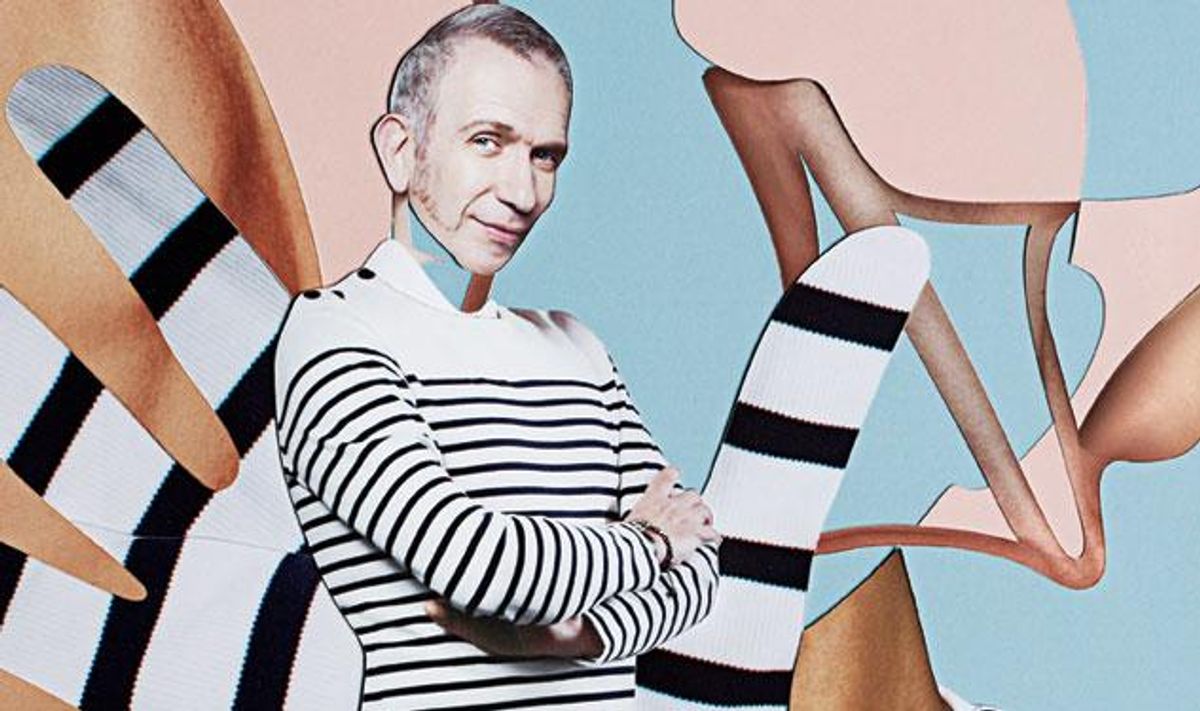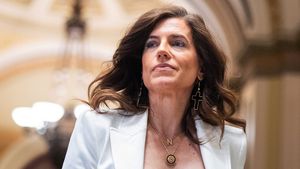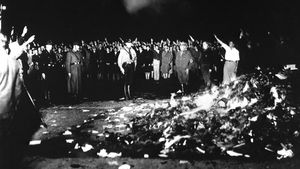 Photo Collages by Damien Blottiere
Photo Collages by Damien Blottiere
Jean Paul Gaultier knows how he will spend his 60th birthday in April. "I will stay in my bed," he says, affecting a theatrically glum expression, folding down his bottom lip. "Crying."
It may provide a moment of philosophical reflection for the designer, on the nickname that has shadowed him since he took his uniquely countercultural and unapologetically gay eye and sold it directly to the heart of high fashion. "I will say, 'Ah, no longer the enfant terrible! Now I am the old terrible,' " he jokes. Despite no longer being a spring poulet, the whiff of youthful, jubilant anarchy still clings to Monsieur Gaultier like his signature fragrance.
I wait for the designer on the second-floor suite of his Paris atelier, which is up a comically grand, baroque stairwell, surrounded by lonely mannequins, mirrored partitions, and frescoes of his latest campaign imagery -- a Sistine Chapel of canary-yellow corsetry. Gaultier is downstairs in his showroom, talking a princess (whom he won't name) through her wedding dress. As a bespoke couturier, he is still in high demand. "I was never an empire-builder," he says later, "the business did not concern me." On completing his royal nuptial business, he bounds into the room.
There is nothing subtle about Gaultier: His gestures are roomy, his accent drunk on its own Gallic extravagance, like somebody doing an impression of a Frenchman. He is in fine physical shape. "I am doing, not a diet, but eating how I should have ate before," he says. "It's no secret. A lot of fruit in the morning, protein and green vegetables, no sugar." His volume and energy is of a man half his age. Tellingly, save for the odd glass of Champagne, he rarely drinks. "Thirty years ago, I had hepatitis," he says, "not the horrible one. But I can feel it when I drink."
SLIDESHOW: Exclusive Gaultier Looks From 1990 to Today
The only visual disappointment in meeting a man whose career I have followed with a fan's eye is that he's not wearing a Breton stripe, the sartorial sailor detail he stole over 40 years ago and made his own. He first used the stripe as a diametric tribute, both to the Rainer Werner Fassbinder movie Querelle ("The atmosphere of that film was like a fever, elemental") and his own pleasant childhood in Parisian suburbia. "I used to see them at flea markets," he says of the sweaters. "I made one into a dress, something of a man for a woman. So tres bien. Leslie Winer was the model. So beautiful. The first androgynous model. Fabulous. She was moving like a guy. She worked with William Burroughs. I gave her an umbrella, and, without even telling her, she carried it like James Dean in East of Eden down the catwalk. That attitude was so fantastic." Voila: the '80s.

Gaultier's grand gift as a designer has been to subvert the rigorous rules applied to masculinity and femininity in fashion. The "enfant terrible" tag was only ever a euphemism by the straight media attempting to get their heads around his bringing gay subcultures to the masses. "Exactly, definitely it was that," he concurs. "That name came from people who did not know what to say about me. People were interested in me and they didn't know what to call it. So they said, 'Enfant terrible.' I was against the codes we had in Paris. Through clothes, I felt that you could say something. In my shows, I could show a different type of beauty. Through my collections, I tried different casting, different ways of walking, and I loved to show ambiguity. What is masculine and what is feminine, anyway? Why should men not show that they can be fragile or seductive? I am only happy when there is no discrimination."
In an age of mass-market designer clutches and fragrances, the idea of clothing as a form of cultural revolt feels almost anachronistic. But Gaultier had been incubated amid the ideological temperament of punk and the New Romantics. As a design hand at Pierre Cardin at the start of the '70s, employed without qualification as an 18-year-old, he had presented to the grand master of Modernism a wedding dress that fit two people. "He didn't make it, but he loved the idea," Gaultier says. "It wasn't like an old French house. It wasn't that old prostitution of doing everything for money; it was doing things for the love of the idea. He taught me to be truly free-spirited."
SLIDESHOW: The Fashion World of Jean Paul Gaultier: From the Sidewalk to the Catwalk
This unbridled approach to his life and work is what has kept him relevant throughout his career. "He's always understood fashion as it's related to the broader sphere -- to pop culture and culture at large," says Laura Brown, the features and special projects director at Harper's Bazaar. "He has a wonderful sense of humor about fashion and himself. I saw him at Christmas, and instead of an angel on his tree, he had a teddy bear in a striped top. He has a sense of whimsy and doesn't worry about being cool. He's done crazy things for us, like dressed as a nun, and we painted him in stripes. He runs an empire, but he still has that glimmer in his eye."
Gaultier attributes his cheery demeanor to growing up in a family similarly free of institutional rigor. Individuality was encouraged. "My parents never said anything bad about gay people," he says. "My grandmother, also, was very clever. I was maybe 11 or 12, and she gave me a book about Christian Dior. It said that he was gay. So I realized that boys could go with boys. I was a little confused at this point, in love with Romeo and with Juliet. I had the great example of Yves Saint Laurent and Mr. Berge, so I understood very easily that men could go to parties as a couple. They set that example. In fashion, you are not rejected because you are gay. I felt like everything was normal in the job I wanted to do."
When he was 12, the Gaultier family watched the Sidney Poitier film Guess Who's Coming to Dinner, and the young Jean Paul asked his parents what they would do if he were to bring home a black girlfriend. "They said, 'If you love each other, that is all we care about. We will not say anything. Love is always good,' " he recalls. "A few years later, when I said that the girl is perhaps not a girl, they said the same: 'If you love each other, perfect.' That gave me peace."
SLIDESHOW: Exclusive Gaultier Looks From 1990 to Today

His cross-gender curiosity spilled seamlessly over to his work. Famously, Gaultier began dressing his teddy bear, Nana, as a child. "In the cone bra," he says, "a long time before Madonna." In the pop icon, he found his most famous populist figurehead and fan. He had already cultivated figures with striking subcultural resonance; he introduced the terrifying Parisian nightclub scion Farida Khelfa to Jean-Paul Goude and courted the French 'Punk Queen,' Edwige. He featured a then-unheard of Jean-Claude Van Damme on his first menswear show invite, "in a tuxedo jacket, a fez, a turtle neck, and a mask. At this time, he was just another karate champion." But his relationship with Madonna was to pivot on a higher watermark for fashion and pop-cultural subversion in her Blond Ambition tour.
SLIDESHOW: The Fashion World of Jean Paul Gaultier: From the Sidewalk to the Catwalk
They had met earlier. "She wore one of my white corset dresses to the premiere of Desperately Seeking Susan in New York," he remembers and then reflects on the first MTV Video Music Awards at Radio City Music Hall, at which she performed "Like a Virgin" in a cotton-candy-colored wig to hesitant industry applause. "The atmosphere was truly scandalous," he says. "People didn't appreciate it at all. Me and my friends were obsessed by her. Why? Because it was a woman, and a woman cannot be provocative on her own terms. It was symbolic. I felt very close to her. It sounds maybe pretentious, but what she was showing, the kind of girl she was, was very attractive to me. She was confronting all the things I was confronting about the inequality of the sexes." They were instantly kindred spirits. "I said later, if she hadn't asked me to make clothes for her, I would've killed the one that she did ask," he says.
Their collaborations are well documented in The Fashion World of Jean Paul Gaultier: From the Sidewalk to the Catwalk, a divine retrospective of his work currently on tour (it arrives in San Francisco's de Young Museum this month). The accompanying book to the show is a fashion archivist's fantasy piece: men in skirts, the golden age of the supermodel, aggressive underwear as outerwear, all delivered with witty uproar. The breadth of Gaultier's reach is astonishing. He has costumed films for Peter Greenaway, Luc Besson, and Pedro Almodovar. One page uncovers the legendary sleeve for Cameo's Word Up! album, another an Anton Corbijn image of Nirvana, with Kurt Cobain resplendent in one of his sequined knits.
If everything is delivered with a devil-may-care attitude to upend fashion imagery, it was because, well, the devil did care. He cared a lot. His association with AIDS fundraising was atomized after losing his long-term lover and business partner, Francis Menuge, to the disease in 1990. "Just after he died, I said to myself, 'What do I do now? Do I stop?' " he reflects now. "At least I have done what I set out to do. Maybe I even went further than I thought I would. This was only ever for me about doing the thing I love and enjoying my job. He was maybe more ambitious than me. All I wanted to do was make my own collection under my own name. You know the expression about losing an arm? It was like that. He was both my arms. Maybe he was the legs, too? The heart, definitely."
It isn't difficult to read everything that has happened since as a kind of tribute. "My life is my work," Gaultier says. "Very quickly, I started to see it as our baby, in some way. It was what we had in common. So I went on with it. This was all his and my creation. All of it."
SLIDESHOW: Exclusive Gaultier Looks From 1990 to Today
SLIDESHOW: The Fashion World of Jean Paul Gaultier: From the Sidewalk to the Catwalk




 Photo Collages by Damien Blottiere
Photo Collages by Damien Blottiere

















































































